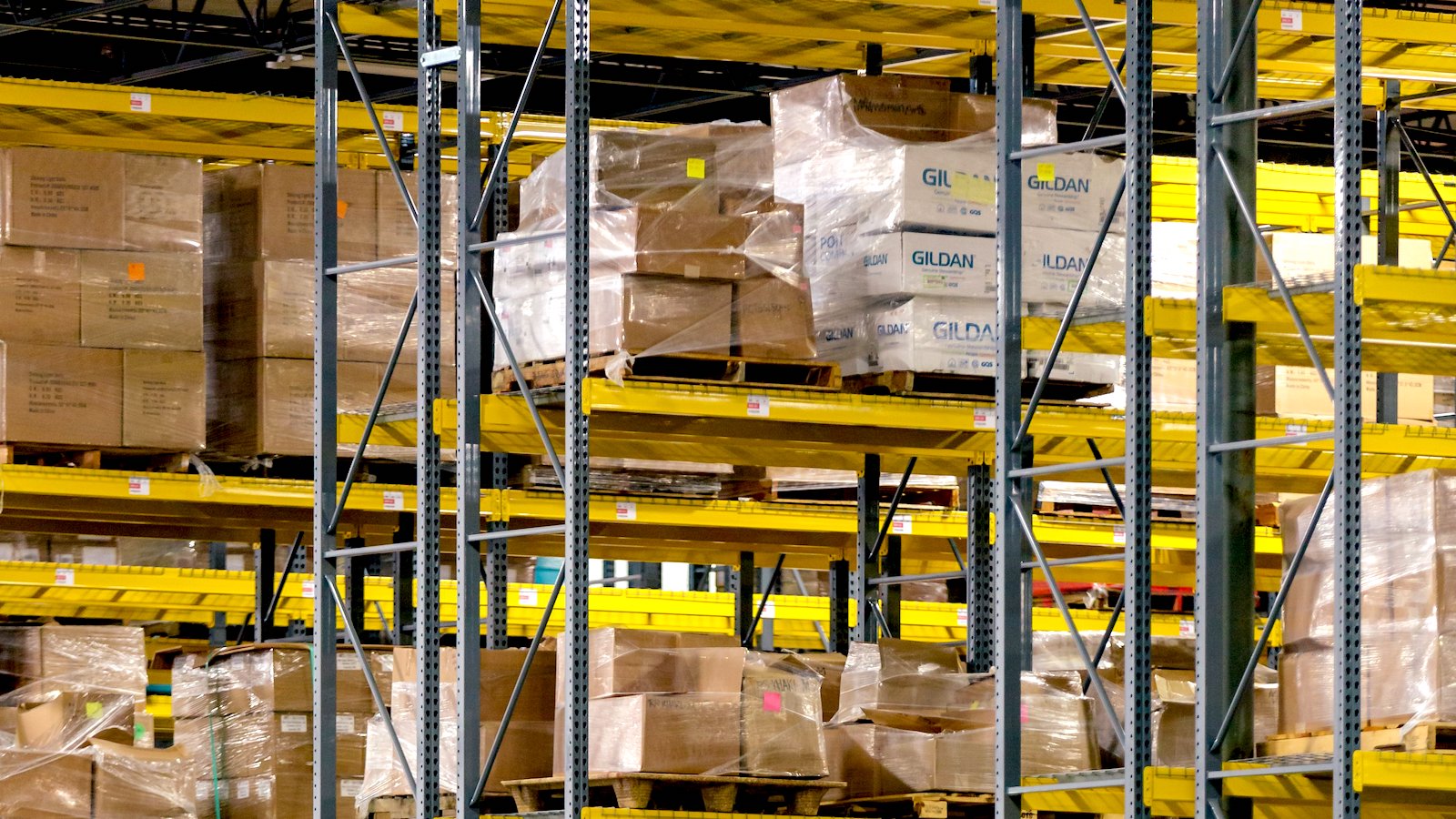Table of Contents
** Minutes
What is a warehouse racking system?
What are racking systems used for in warehouses?
How much do warehouse racks cost?
How to set up a warehouse racking system
How is shelving load calculated?
Warehouse racking systems and OSHA inspections
Your garage is overflowing.
Your spare rooms are packed.
Every living space is full of boxes.
If this is true for you, then you are probably already considering moving inventory to a warehouse.
But in order to transition to warehousing successfully, you will need the right equipment. While storage bins, storage cabinets, and totes suffice for home storage, warehousing requires a warehouse racking system, or special metal shelving units that hold pallets or boxes of inventory.
Warehouse racking systems directly impact the efficiency of your warehouse management, your order accuracy, speed of fulfilment, and worker safety — so before committing to a racking system, it’s important to do your research. By understanding the different types of warehouse racks and the costs associated with each type, you’ll be able to find the best model for your warehouse the first time.
In this article, we take a closer look at warehouse racking systems — what they are, why it’s important to choose the right ones, the challenges of managing and maintaining warehouse racking systems, and how ShipBob can handle all internal warehouse processes with ease.
What is a warehouse racking system?
Warehouse racking systems (also called pallet rack systems) are storage systems used in most warehouses to hold inventory.
Warehouse racking systems consist of several warehouse racks, which are industrial shelving units made of metal designed to store boxes or pallets in multiple levels of horizontal rows, stacked on top of each other.
What are racking systems used for in warehouses?
Businesses use racking systems to optimise their warehouse storage. Racking systems can double or triple your warehouse’s inventory holding capacity without increasing the square footage you pay for, making them a cost-effective solution for small businesses looking to maximise their warehousing storage space.
A rack system also helps keep inventory organised, as it provides a dedicated storage space for each SKU. For fast-growing companies transitioning away from haphazard garage storage, steel shelving racks with storage bins or pallets can improve inventory management, and make it easier to find and pick units.
How much do warehouse racks cost?
The cost of a racking system depends on the type of racking system you purchase. In general, the simpler the racking system, the less expensive it will be.
Here is a list of various racking system designs, as well as descriptions and cost estimates (including installation) for each:
System | Description | Cost per Pallet Position* |
Selective Racking | The most common type of racking. Two racks are often placed back-to-back to reduce aisle space needed.
| $50 – $80 |
Double Deep Racking | Four Selective Rack rows placed back-to-back to create storage that is 2 pallets deep in each slot.
| $75-$105 |
Drive-In Racks/ Drive Thru Racking | The most high-density storage available. Forklifts drive through aisles, and load and retrieve pallets from the same point.
| $115-$140 (depending on rack depth) |
Pushback Racking | “Vending machine” storage. Pallets are loaded into the back of the rack, and slide forward when pallets are removed from the front.
| $150-$300 |
Pallet Flow Racks | Similar to Pushback Pallet Racking, but includes a system of sloping rollers or conveyor belts for carton flow. Pallets are loaded at the elevated end, and gravity rolls each pallet down as other pallets are removed.
| $200-$400 |
Cantilever Racks | Do not have vertical support bars.
| Single-sided: $850-$1,700 Double-sided: $1,100-$2,500 |
* “Pallet position” refers to a single slot in a warehouse rack that can fit one 48” by 40” pallet. One warehouse rack usually has multiple pallet positions, with the precise number of positions ranging from 2 to 10.
While warehouse racks themselves are a significant investment, there are additional costs to racking that you’ll need to consider as well.
Racking systems usually require additional add-ons (such as cross bars, wire decking, and protectors for uprights & aisle ends) which can range anywhere from $12 to $125 each.
In addition, you may need to purchase additional warehousing square footage to accommodate the racks, which will vary in cost depending on location and demand for ecommerce warehousing.
You may also require material handling equipment to store and retrieve inventory held in warehouse shelving, which may include pallet jacks, forklifts, dollies, workbenches, or other pieces. Used equipment will of course cost less, while new equipment will cost more, but both will depreciate in value over time.
Taking into account all of these costs, setting up a high-quality warehousing rack system for a larger operation can easily cost around $100,000 or more. Because of the costs, smaller operations may find it more cost-effective to outsource storage and warehousing to a 3PL or logistics service provider, to avoid investing in expensive assets too early on.
“Even when evaluating other 3PLs, ShipBob was by far the easiest, most reasonably priced option with the nicest, most genuine people. Other 3PLs gave me confusing pricing with many per-item fees, which were hard to grasp and calculate ultimate costs. Thinking big picture, it was an incremental cost for me to ultimately sell a lot more. My business has tripled and I got my life back.”
Anastasia Allison, founder of Kula Cloth
How to set up a warehouse racking system
Once you decide which type of racking system is the best for your business, the next step is to carefully consider how to arrange that system to maximise efficiency, manage inventory, avoid bottlenecks, and ensure warehouse safety.
Here are some aspects of warehouse racking to plan for in your business’s warehouse.
Spacing between racks
There should be ample space between racks so that materials are accessible. While your instinct may be to place racks closely together to make the most of your floor space, you shouldn’t do so at the cost of picking efficiency.
Consider how pallets are loaded into the racking system, and make sure not to block any pallet loading or picking points (particularly if you use pushback or pallet flow racks).
Aisle width
Your aisles should be wide enough for any material handling equipment such as forklifts or pallet jacks to move around with ease to ensure safety and efficiency. With certain types of racking systems, such as double deep racking, two racks can be placed back-to-back to conserve space and allow for wider aisles.
Labeling & organisation
To improve your stowing and picking efficiency, follow a consistent system to organise your warehouse and inventory.
This system does not have to be ordered alphabetically or by SKU number — in fact, it is often far more efficient to organise inventory based on picking practicality. Try storing items that are commonly purchased together near each other, grouping seasonal products, and placing best-selling items in easily accessible locations to make picking quick and intuitive.
Once you settle on a system, label each storage location prominently, and create a master list of products’ aisle numbers and placements for pickers to refer to.
Layout of the system
When first planning your warehouse layout, ignore any obstructions in your warehousing space (such as columns, mezzanines, workbenches, etc.). Once you have an initial plan, factor in and accommodate for those obstructions, changing as little as possible from your original plan.
While this approach does not guarantee an efficient warehouse, it allows you to prioritize efficiency from the beginning, without getting bogged down in details too early.
Longer rows of racks typically make the most efficient warehouse layout. Bisect these long rows periodically with cross-aisles to make moving from one aisle to the next quicker and simpler.
How is shelving load calculated?
Before you begin to load your shelves with inventory, you absolutely must calculate shelving load capacity for each rack, and display that number prominently.
Without awareness of how much weight a rack can hold, shelves can easily get overloaded. This could result in falling pallets or cause the entire rack to collapse — so to create a safer work environment for your employees, shelving loads must be respected and up-to-date at all times.
Warehouse racks are made of two main components: vertical uprights and horizontal beams. These form the framework, with other components adding support (wood or wire decking to make the “floor” of the pallet position, braces, baseplates, etc.).
To calculate your shelving load capacity, you will need to assess many different factors, including:
- Upright capacity — depends on the heights, widths, and spacing of the uprights (the farther they are spaced out, the less weight they’ll be able to hold)
- Beam capacity — depends on the rack’s depth-to-length ratio, as well as the thickness and length of each beam (the longer and thinner the beam, the less weight it will hold and the more likely it will bow over time)
- Height of each pallet position — from the top of one beam level to the top of the next
- Number of storage levels — the higher the level, the less weight it can hold
- Material — quality, thickness, strength
When making your calculations, refer to the load capacity chart provided by the manufacturer, since warehouse rack capacities can vary across make and model.
Once you have calculated how much weight each warehouse rack can hold, plan your inventory storage accordingly.
To maximise your warehouse rack’s lifespan, never fill it to its full weight capacity — instead, make sure that the total pallet weight is always lighter than that given rack’s weight capacity. In addition, make sure that pallet weight is always uniformly distributed.
If your warehouse rack is adjustable, calculate the maximum total pallet weight you will ever hold on one rack, and work with your rack installer to tweak the design so that the rack’s weight capacity is well above that total.
Warehouse racking systems and OSHA inspections
Although OSHA doesn’t lay out any specific guidelines for warehouse racking safety, employers are still obligated to ensure that their racking systems don’t pose an occupational hazard for their workers.
You should regularly inspect your warehouse racking systems for any obvious hazards (such as damaged warehouse equipment, improper installation, and missing capacity displays), as well as general cleanliness, waste disposal, loading and receiving SOP performance, and proper inventory accounting.
Warehouse inspections should be performed at least annually, though high-traffic racking areas and narrow aisles require more frequent inspections.
This will ensure that your warehouse is ready for any OSHA inspections, which are typically conducted without advance notice.
Warehousing is a pain – leave it to the experts
Purchasing, installing, and maintaining warehouse racking systems on your own is a challenge — and it’s just the start of your warehouse operations.
As your business grows, you will also need to navigate inventory management, order fulfilment, SOP development, warehouse automation, and other critical warehouse functions on a much larger scale.
To save themselves time, money, and trouble later on, many small business owners choose to outsource their warehousing logistics to third party logistics providers (or 3PLs) early on.
Partnering with a 3PL like ShipBob is usually much easier than handling warehousing yourself, as companies like ShipBob have years of expertise and a thorough knowledge of best practices that they use to optimise operations.
It is also usually more profitable for small businesses, as ShipBob grants merchants access to infrastructure, warehouse equipment, and technology that they cannot afford to invest in themselves.
With ShipBob, you can store your inventory across multiple, strategically placed fulfilment centres so you don’t have to maintain your own warehouse space, and can cut shipping time and cost dramatically.
Moreover, ShipBob’s efficient pick and pack fulfilment ensures that orders get out the door faster without sacrificing fulfilment accuracy.
“The entire process of getting started with ShipBob was so easy. I was handing my business over to someone who was not just a vendor but a partner, one who was going to hear me and understand the complexity of what we do — and have a solution. During our initial conversations, it was never ‘We can’t do that …,’ it was always ‘We can do this and …’ and ‘It’s going to be this or that …’”
Andrea Hamilton, founder of The Finer Things 1920
To learn more about how ShipBob can meet your warehousing and fulfilment needs, click the Request Fulfilment Pricing button below.
Warehouse rack FAQs
Here are answers to the most common questions about retail warehousing.
How much does it cost to rack a warehouse?
The cost of racking a warehouse depends on the size of your operation, the amount of inventory you need to store, and what racking system design works best for your business. In general, warehouse racks can cost anywhere between $50 to $2,500 per pallet position.
How much weight can a pallet rack hold?
The weight capacity of pallet rack systems vary by size, design, and manufacturer. Before storing inventory, calculate your maximum pallet weight and make sure that your warehouse racking system has a weight capacity well above that number.
What is double deep racking?
Double deep racking is a type of warehouse racking system that combines 4 selective pallet racks together to create storage that is two pallet positions deep on both sides. This is a high-density storage solution that enables warehouses to drastically reduce aisle space, and works best for LIFO storage.
Do pallet racks need to be bolted to the floor?
Yes. According to standard regulations, pallet racks must always be bolted to the floor — especially in a warehouse where mechanical handling equipment is used. Floor bolting stabilizes warehouse racking, and can even increase its weight capacity.
How much space do you need between pallet racks?
There should be at least 3 inches of space between any two pallet racks to avoid damage or accidental impact, even if you are placing the racks back-to-back. When leaving space for aisles, leave enough space for people and equipment to safely move through.
How wide do aisles need to be in a warehouse?
The width of aisles can vary depending on what type of warehouse equipment needs to fit through them. Aisles can be as narrow as 6 feet or less, but if you plan to use forklifts, pallet jacks, or other heavy duty equipment, aisles will need to be at least 12 feet wide.
Do warehouse racks need a permit?
In most cases, you need a permit for warehouse storage racks to ensure that the system is up to code, that workplace safety requirements are met, and to minimise product damage. These are typically fees associated with these permits, so be sure to budget fees into your overall cost estimate for a warehouse racking system.



